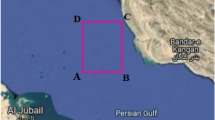Abstract
In this paper, an underwater vehicle was modeled with six dimensional nonlinear equations of motion, controlled by DC motors in all degrees of freedom. Near-optimal trajectories in an energetic environment for underwater vehicles were computed using a numerical solution of a nonlinear optimal control problem (NOCP). An energy performance index as a cost function, which should be minimized, was defined. The resulting problem was a two-point boundary value problem (TPBVP). A genetic algorithm (GA), particle swarm optimization (PSO), and ant colony optimization (ACO) algorithms were applied to solve the resulting TPBVP. Applying an Euler-Lagrange equation to the NOCP, a conjugate gradient penalty method was also adopted to solve the TPBVP. The problem of energetic environments, involving some energy sources, was discussed. Some near-optimal paths were found using a GA, PSO, and ACO algorithms. Finally, the problem of collision avoidance in an energetic environment was also taken into account.
Similar content being viewed by others
References
Bryson AE, Ho YC (1975). Applied optimal control, optimization, estimation and control. John Wiely & Sons, New York, 33–78.
Chyba M, Leonard NE, Sontage ED (2001). Optimality for underwater vehicles. Proceedings of the 40th IEEE Conference on Decision and Control, Orlando, 4204–4209.
Dorigo M, Maniezzo V, Colorni A (1996). Ant system: optimization by a colony of cooperating agents. IEEE Transactions of System Man Cybernetic, 26(1), 29–41.
Dorigo M, Gambardella LM (1997). Ant colonies for the traveling salesman problem. Biosystems, 43(2), 73–81.
Elbeltagi E, Hegazy T, Grierson D (2005). Comparison among five evolutionary-based optimization algorithms. Advanced Engineering Informatics, 19(1), 43–53.
Feng Z, Allen R (2004). Reduced order H∞ control of an autonomous underwater vehicle. Journal of Control Engineering Practice, 12(12), 1511–1520.
Fossen TI (1994). Guidance and control of ocean vehicles. John Wiley & Sons Ltd, New York, 21–55.
Holland JH (1975). Adaptation in natural and artificial systems. The University of Michigan Press, Ann Arbor, Michigan.
Ishii K, Fujii T, Ura T (1995). An on-line adaptation method in a neural network based control system for AUVs. IEEE Journal of Ocean Engineering, 20(3), 221–228.
Jalving B (1994). The NDRE-AUV flight control system. IEEE Ocean Engineering, 19(2), 497–501.
Khanmohmmadi S, Alizadeh G, Pourmahmood M (2007). Design of a fuzzy controller for underwater vehicles to avoid moving obstacles. Proceedings of IEEE Conference on Fuzzy Systems, London, England, 930–935.
Kokotovi PV, Arcak M (2001). Constructive nonlinear control: a historical perspective. Automatic, 37(5), 637–662.
Kumar PR, Dasgupta A, Kumar CS (2005). Real-time optimal motion planning for autonomous underwater vehicles. Ocean Engineering, 32(11), 1431–1447.
Lasdon LS, Mitter SK, Warren AD (1977). The conjugate gradient method for optimal control problem. IEEE Transactions of Automation and Control, 12(2), 132–138.
Neam W, Sutton R, Ahmad SM (2003). LQG/LTR control of an autonomous underwater vehicle using a hybrid guidance law. Proceedings of Guidance and Control of Underwater Vehicles, Newport, UK, 31–36.
Pierrot F, Benoit M, Dauchez P (1998). Optimal thruster configuration for omni-directional underwater vehicles. SamoS: a Pythagorean solution. Proceedings of IEEE OCEANS, Quebec, 655–659.
Spangelo I, Egeland O (1994). Trajectory planning and collision avoidance for underwater vehicles using optimal control. IEEE Journal of Ocean Engineering, 19(2), 502–511.
Sakagami N, Kawamura S (2003). Time optimal control for underwater robot manipulators based on iterative learning control and time-scale transformation. Proceedings of the 2003 IEEE International Conference on Ocean Engineering, San Diego, USA, 1180–1186.
Sage AP, White CC (1977). Optimum systems control. Prentice-Hall, New Jersey.
Shi Y, Eberhart AR (1998). Modified particle swarm optimizer. Proceedings of the IEEE International Conference on Evolutionary Computation, Piscataway, 69–73.
Timothy WM, Randal WB (1998). Successive Galerkin approximations to the nonlinear optimal control of an underwater robotic vehicle. Proceedings of the 1998 IEEE International Conference on Robotics & Automation, Leuven, Belgium, 762–767.
Yoerger DR, Slotine JE (1985). Robust trajectory control of underwater vehicles. IEEE Journal of Ocean Engineering, 10(4), 462–470.
Yoerger DR, Cooke JG, Slotine JE (1999). The influence of thruster dynamics on underwater vehicle behavior and their incorporation into control system design. IEEE Journal of Ocean Engineering, 15(3), 167–178.
Author information
Authors and Affiliations
Corresponding author
Additional information
Mohammad Pourmahmood Aghababa received his B.S. degree in Biomedical Engineering from Isfahan University in 2005. He received his M.S. and Ph.D. degrees both in Control Engineering from the University of Tabriz in 2007 and 2011, respectively. He is currently an Assistant Professor in the Department of Electrical Engineering of the Urmia University of Technology, Urmia, Iran. His research interests include nonlinear control, fractional calculus, and artificial intelligence.
Mohammad Hossein Amrollahi received his B.S. and M.S. degrees both in Electrical Engineering from Sharif University of Technology and the University of Tehran in 1990 and 1994, respectively. He is now a lecturer in the Department of Electrical Engineering of the Urmia University of Technology, Urmia, Iran. His research interests include power systems, renewable energy, and artificial intelligence.
Mehdi Borjkhani received his B.S. degree in Electrical Engineering from Urmia University in 2005. He got his M.S. in Biomedical Engineering from Amirkabir University in 2009. He is now a lecturer in the Department of Electrical Engineering of the Urmia University of Technology, Urmia, Iran. His research interests include signal processing, handwriting techniques, and artificial intelligence.
Rights and permissions
About this article
Cite this article
Aghababa, M.P., Amrollahi, M.H. & Borjkhani, M. Application of GA, PSO, and ACO algorithms to path planning of autonomous underwater vehicles. J. Marine. Sci. Appl. 11, 378–386 (2012). https://doi.org/10.1007/s11804-012-1146-x
Received:
Published:
Issue Date:
DOI: https://doi.org/10.1007/s11804-012-1146-x




